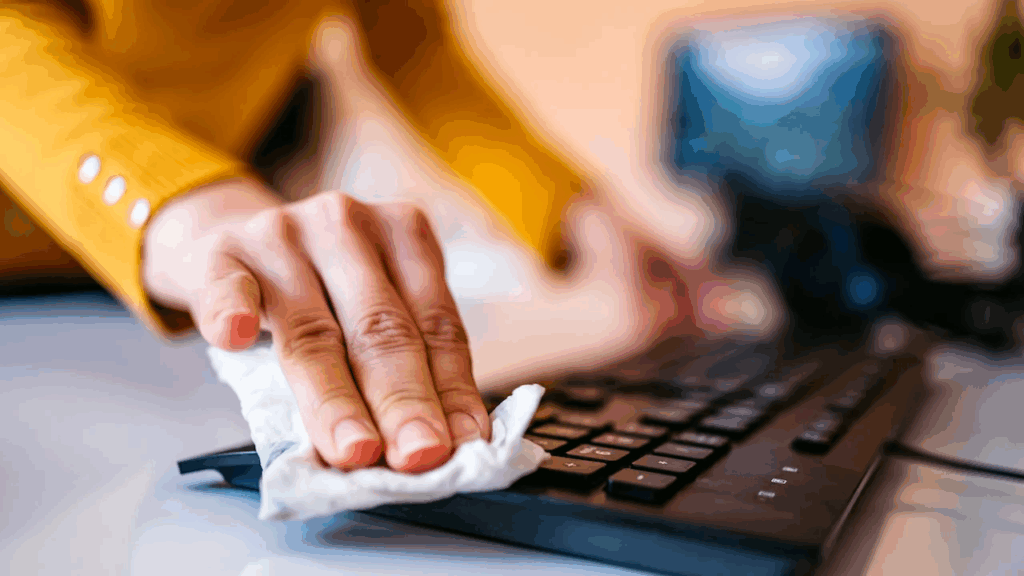Keeping your keyboard clean is super important. A dirty keyboard can slow you down and make typing less fun. Dust, crumbs, and sticky spots build up over time. This makes keys stick or stop working. Plus, dirty keyboards look gross and can spread germs.
Don’t worry though. Learning how to clean keyboard properly is easy. You just need the right tools and simple steps. Clean keyboards last longer and work better. They also feel much nicer to use.
This guide will show you everything you need to know. We’ll cover daily cleaning, deep cleaning, and how to fix common problems. By the end, your keyboard will look and work like new.

Why You Should Clean Your Keyboard Regularly
Your keyboard gets dirty fast. Think about how often you touch it every day. Your fingers leave oils, sweat, and tiny bits of skin. Food crumbs fall between keys when you eat at your desk. Dust settles on everything over time.
A dirty keyboard causes real problems. Keys can stick or feel mushy. Some keys might stop working completely. The letters on key caps can fade or wear off. Worse yet, bacteria and germs love to live on dirty surfaces.
Regular cleaning prevents all these issues. Clean keyboards respond better when you type. This helps you work faster and make fewer mistakes. Clean keyboards also look professional and make a good impression.
Plus, cleaning saves you money. A well-maintained keyboard lasts much longer. You won’t need to replace it as often. This is especially important if you have an expensive gaming or mechanical keyboard.
What You Need to Clean Your Keyboard
Good news – you don’t need fancy tools to clean your keyboard. Most cleaning supplies are things you already have at home. Here’s what works best:
Basic Cleaning Supplies
- Soft microfiber cloth
- Cotton swabs (Q-tips)
- Compressed air can
- Isopropyl alcohol (70% or higher)
- Small bowl for water
- Soft brush or old toothbrush
Optional Tools for Deep Cleaning
- Keycap puller (for mechanical keyboards)
- Small screwdriver
- Plastic spudger tools
- Cleaning slime or putty
Don’t use harsh chemicals like bleach or ammonia. These can damage your keyboard. Avoid using too much water too. Liquid can get inside and break the electronics.
Quick Daily Cleaning Steps
Daily cleaning takes just a few minutes. But it makes a huge difference over time. Do this every day or at least a few times per week.
Step 1: Turn Off and Unplug
Always turn off your computer first. Unplug your keyboard if it’s wired. For wireless keyboards, turn them off or remove batteries. This prevents accidental key presses while cleaning.
Step 2: Shake Out Loose Debris
Turn your keyboard upside down. Gently shake it to remove loose crumbs and dust. You’ll be surprised how much stuff falls out. Tap the back lightly to get stubborn pieces.
Step 3: Wipe Down the Surface
Use a slightly damp microfiber cloth. Wipe the top of all keys and the keyboard surface. Don’t use too much water. The cloth should be barely damp, not wet.
Pay extra attention to keys you use most. These include the space bar, enter key, and common letters. These spots get the dirtiest fastest.
Step 4: Clean Between Keys
Use cotton swabs for tight spaces. Dip them lightly in isopropyl alcohol. Clean around each key and in the gaps. This removes oils and sticky residue.
Work systematically across the keyboard. Start from one side and work to the other. This way you don’t miss any spots.
Deep Cleaning Your Keyboard
Sometimes quick cleaning isn’t enough. Deep cleaning gets rid of built-up grime and sticky spots. Do this once a month or when your keyboard feels really dirty.
Preparing for Deep Cleaning
Take a photo of your keyboard first. This helps you remember where each key goes. Different keyboard layouts can be confusing when putting keys back. If you’re unsure about your specific keyboard layout, check our guide for reference.
Make sure you have good lighting. Work on a clean, flat surface. Lay out a towel to catch any parts that might fall.
Removing Keycaps (For Mechanical Keyboards)
Mechanical keyboards let you remove individual keys. This makes deep cleaning much easier. Use a keycap puller or carefully use your fingers.
Pull straight up on each keycap. Don’t wiggle or twist them. This can break the key or the switch underneath. Start with less important keys first to practice.
Some keys are bigger and have metal wires underneath. These include the space bar, shift keys, and enter key. Be extra careful with these. The wires can be tricky to put back.
Cleaning Individual Keycaps
Put all removed keycaps in a bowl of warm, soapy water. Use mild dish soap – nothing harsh. Let them soak for 10-15 minutes.
Use an old toothbrush to scrub each keycap gently. Pay attention to the sides and bottom where grime builds up. Rinse with clean water and dry completely.
Make sure keycaps are 100% dry before putting them back. Wet keycaps can damage your keyboard’s electronics.
Cleaning the Keyboard Base
With keycaps removed, you can see the keyboard’s base. Use compressed air to blow out dust and debris. Hold the can upright and use short bursts.
Clean the switches and base with cotton swabs and isopropyl alcohol. Be gentle around the switches. Don’t push down on them too hard.
For stubborn spots, use a soft brush. An old toothbrush works great for this. Brush gently to avoid damaging delicate parts.
Cleaning Different Types of Keyboards
Different keyboards need different cleaning methods. Here’s how to handle the most common types:
Membrane Keyboards
These are the most common keyboards. The keys don’t come off easily. Focus on surface cleaning and using compressed air.
Use cleaning slime or putty to get into tight spaces. This stuff picks up dust and crumbs without leaving residue. It’s especially good for membrane keyboards.
Mechanical Keyboards
These keyboards have individual switches under each key. You can usually remove keycaps for thorough cleaning. This makes them easier to clean deeply.
Be careful with the switches when cleaning. Don’t get liquid inside them. Some switches are water-resistant, but it’s better to be safe.
Laptop Keyboards
Laptop keyboards are delicate. Don’t try to remove keys unless you’re experienced. Focus on gentle surface cleaning and compressed air.
Use less liquid on laptop keyboards. They’re more sensitive to moisture damage. Stick to barely damp cloths and cotton swabs.
Gaming Keyboards
Gaming keyboards often have RGB lighting and special features. Clean them like mechanical keyboards, but be extra careful around electronics.
Check if your gaming keyboard has software for testing functionality after cleaning. This helps make sure everything still works properly.
Dealing with Common Keyboard Problems
Cleaning can fix many keyboard issues. Here are the most common problems and how cleaning helps:
Sticky Keys
Sticky keys are usually caused by spilled drinks or food. The residue makes keys stick when you press them. Deep cleaning with isopropyl alcohol usually fixes this.
For really stubborn sticky spots, you might need to remove the keycap. Clean both the key and the switch underneath thoroughly.
Keys Not Working
Sometimes dirt or debris blocks the key mechanism. Compressed air often fixes this problem. Blow air around the problem key from different angles.
If that doesn’t work, the key might need deeper cleaning. Remove the keycap if possible and clean the switch mechanism.
Mushy or Unresponsive Keys
This usually means dirt has built up inside the key mechanism. Again, compressed air is your first tool. Follow up with careful cleaning around the affected keys.
Faded or Worn Key Labels
Cleaning can’t fix this, but it can prevent it. Regular gentle cleaning keeps key labels from wearing off quickly. Avoid harsh chemicals that can damage printing.
Maintaining Your Keyboard After Cleaning
Good habits keep your keyboard cleaner longer. Here are simple things you can do every day:
Wash Your Hands
Clean hands mean a cleaner keyboard. Wash your hands before using your computer. This reduces oils and dirt transfer.
Eat Away From Your Keyboard
Food crumbs are a keyboard’s worst enemy. Try to eat meals away from your computer. If you must snack while working, use a plate and be careful.
Cover Your Keyboard
Use a keyboard cover when you’re not using it. This keeps dust from settling on the keys. It’s especially helpful if you don’t use your computer every day.
Clean Spills Immediately
If you spill something on your keyboard, clean it right away. Turn off your computer and unplug the keyboard first. Then clean up the spill before it has time to cause damage.
For liquid spills, turn the keyboard upside down immediately. This helps liquid drain out instead of going deeper inside.
When to Replace Your Keyboard
Sometimes cleaning isn’t enough. Here are signs that your keyboard might need replacement:
- Multiple keys don’t work even after cleaning
- The keyboard feels mushy or unresponsive overall
- Key labels are completely worn off
- The keyboard case is cracked or damaged
- Cleaning doesn’t improve performance anymore
Don’t feel bad about replacing an old keyboard. Technology improves over time. A new keyboard might have better features and feel nicer to use.
If you use your keyboard for work meetings, you might want to learn about useful keyboard shortcuts that can make your video calls more efficient.
Professional Cleaning vs DIY
Most keyboard cleaning is easy to do yourself. But sometimes professional cleaning makes sense:
When to Clean Yourself
- Regular maintenance cleaning
- Minor spills and dirt
- Surface grime and dust
- Sticky keys from normal use
When to Consider Professional Help
- Major liquid spills that got inside
- Valuable vintage or rare keyboards
- Complex mechanical keyboards you’re not comfortable taking apart
- When cleaning hasn’t solved persistent problems
Professional cleaning costs money, but it might save an expensive keyboard. Weigh the cost of cleaning against the cost of replacement.
Final Tips for Clean Keyboards
Learning how to clean keyboard properly takes practice. Start with gentle methods and work up to deeper cleaning as you get comfortable.
Always test cleaning products on a small area first. This prevents damage if something reacts badly with your keyboard materials.
Take your time when cleaning. Rushing can lead to broken keys or damaged electronics. It’s better to clean thoroughly once than to have to fix mistakes.
Remember that prevention is easier than cleaning. Good habits keep your keyboard cleaner and working better for longer.
A clean keyboard makes typing more enjoyable and can even help you work more efficiently. Whether you’re using it for work, gaming, or general computer use, maintaining your keyboard is a simple way to improve your computing experience. Regular cleaning ensures your keyboard will serve you well for years to come.
